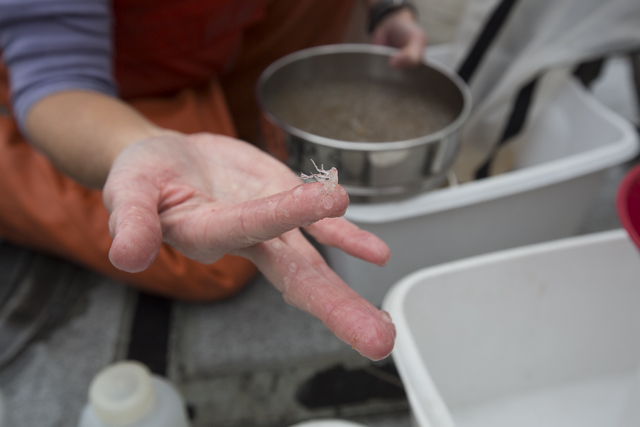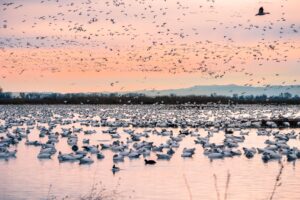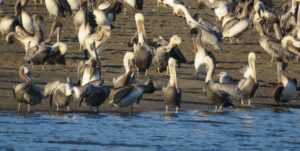welve feet above the Pacific Ocean on the flying bridge of the research vessel Fulmar, Jason Thompson, a volunteer observer with Point Blue Conservation Science, sits at the alert, eyes glued to his binoculars. It’s eerily calm – no wind, hardly any swell and no fog – a perfect day for conducting research. Out here, halfway between the Golden Gate and the Farallon Islands, the water and the sky seem to mirror each other.
It’s so quiet that I can perfectly hear the words as Thompson mutters them.
“There’s an orca,” he says. His eyes never leave the binoculars, but a beat later he gets louder. “I’m not even kidding, there’s an orca.” This time somebody else hears him and suddenly the Fulmar is swerving left and the flying bridge fills up with everyone on board – scientists and volunteers from NOAA, Point Blue, and the Farallones National Marine Sanctuary Association. The engine cuts and the Fulmar bobs on its own wake.
A black fin rises from the water and the excited conversations suddenly go quiet. The killer whale, a big male, is coming right at us. The fin dips back under the water and the orca glides like a ghost underneath the boat, its white markings tinted aquamarine by the glassy ocean. It surfaces again near the stern, as if wondering what we’re doing out here, before it dips back underwater and disappears. For a moment, nobody says a word. Then the engine roars to life, the boat swings in the water, and we motor again toward the Farallon Islands, which rise like a row of cracked teeth in the distance.
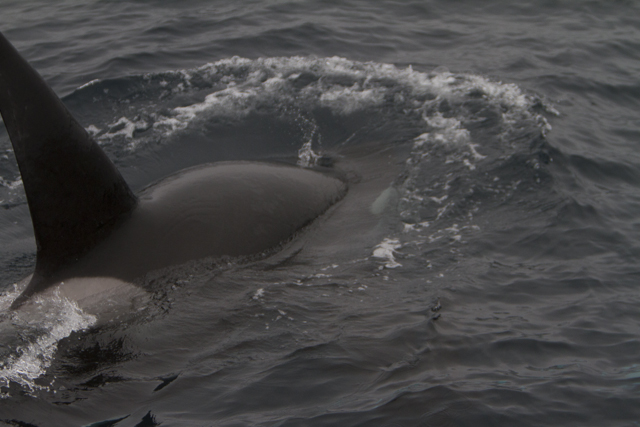
or the past decade, NOAA and Point Blue Conservation, along with a few other organizations, have partnered on the Applied California Current Ecosystem Studies, or ACCESS, to study the ocean waters just west of the Bay Area. The project has focused on everything from ocean acidification and its affect on zooplankton to the distribution of marine wildlife.
Today, on the second day of an eight-day cruise that’s the final expedition of 2014, the scientists are collecting data from a transect divided into five stations. At each station the vessel stops to measure water quality and deploy nets for sampling the water column while a team of spotters gathers on the bridge for four timed observations.
The Gulf of the Farallones and Cordell Bank National Marine Sanctuaries are some of the richest marine waters in the world. Combined, the sanctuaries encompass more than 2,000 square miles of open ocean and coastal habitat. They are the destination of long distance migrations for species like leatherback sea turtles; each fall, the sanctuaries host one of the largest gatherings of white sharks in the world. “This place is a showcase of biodiversity,” says Mary Jane Schramm, a NOAA spokeswoman.
“These are important waters that provide a refuge for species on the brink of extinction,” she adds. “But both sanctuaries lie in the middle of an ocean highway connecting the Bay Area to the rest of the world.”
One of the missions of the ACCESS expeditions has been to provide data on a place “in need of protection from oil spills, boat and aircraft wildlife disturbance, and other impacts,” Schramm says. Information about locations where whales gather has provided useful data to avoid shipstrikes, which kill an unknown number of whales per year, and NOAA and Point Blue have now created an iPhone app that lets the public record its own whale sightings to relay to researchers and ship captains.

he researchers keep an eye out for whales. But the main focus is on what whales eat: krill, or zooplankton. The two most common species in the sanctuaries – Euphasia pacifica and Thysanoessa spinifera – look like tiny shrimp, no bigger than a pinky nail. When actively feeding, a humpback whale can eat one ton of krill per day. Blue whales, which eat krill exclusively, can eat up to 4 tons per day. If the krill isn’t doing well, the whole ecosystem suffers.
A few miles beyond the Farallon Islands, the Fulmar slows as it approaches the day’s transect. There’s a little more swell out here on the open ocean, but there’s still no wind or fog and the researchers prepare for the first sample. Jaime Jahncke, the California Current director at Point Blue, stands on the back of the Fulmar in a pair of bright orange fisherman’s trousers. He watches as a weighted net disappears into the water. The net will drag behind the Fulmar at three different depths and capture a sample of what’s living there.
What makes the California Current such a rich and diverse ecosystem is a phenomenon called upwelling. Where the Fulmar rolls in the swell – a little more than 30 miles west of San Francisco – the continental shelf abruptly meets the deep ocean. When the winds blow, as they often do in the Gulf of the Farallones, the warm water gets pushed around, allowing nutrient-rich waters from the deep ocean to rise to the surface. Earlier this year, strong offshore winds fueled the upwelling effect. But by late July, the winds had calmed and the upwelling had stopped. In a publication brief released in mid-September, Point Blue researchers noted that the mixed year for the upwelling had meant mixed success for seabird breeding around the Farallones: Cassin’s auklets, which have done exceptionally well over the last few years, had a strong first brood, but unlike in previous years, failed to fledge a second brood. Common murres had their lowest productivity in five years, with an almost 30 percent rate of egg failure, while Western and California gull productivity declined, with California gulls failing to fledge any chicks.
Twenty minute later the net is out of the water and researchers are poking around a clear, gelatinous goop made of other zooplankton, looking for krill. There’s very few – not a very good sign – which Jahncke attributes to the stalled upwelling. “The water has stayed warm on top,” he says. “It’s about 65 degrees, when it’s normally 45-50. There’s a layer of stratified warm water that’s 60 to 90 feet deep and is associated with gelatinous zooplankton.”
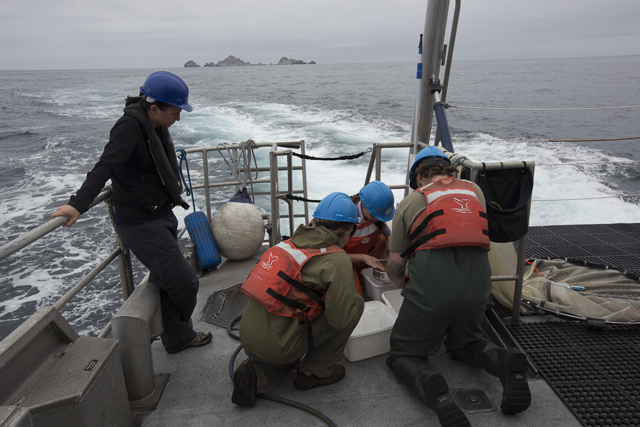
n between the sampling stations, the researchers gather on the flying bridge for timed observations. Armed with high-powered binoculars, scientists and volunteers scan the horizon. Small talk fades away and a quiet settles over the Fulmar – late in the day, in the last observation period, the morning orca is still the wildlife highlight. As the boat heads back toward the coast, rocking gently on the calm ocean, the islands pass by again. The sky seems to blur with the water, a nearly monochrome expanse broken by the thin black coastline in the distance. Occasionally, somebody calls string of code words that Jahncke types into a laptop, denoting the species, its distance and bearing from the boat as well as its behavior, sex and age.
The quiet is broken by Captain Dave Minard’s voice, which crackles on the loudspeaker above overhead. “One minute left,” he says. The researchers keep their eyes to their binoculars, but no one says a word. The loudspeaker beeps, signaling the end of the final observation period.
“Did you see any whales?” asks Jan Roletto, NOAA’s Research Coordinator for the Farallones National Marine Sanctuary.
“Nope,” says Dru Devlin.
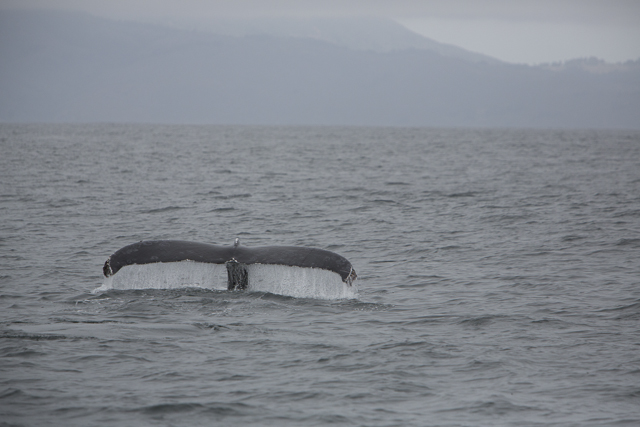
ith the day’s research complete, the scientists and volunteers leave the flying bridge. The engine roars to life and, once again, Jason Thompson is alone scanning the horizon with his binoculars.
In the cabin downstairs, Jaime Jahncke supervises data entry from the day’s findings. “It’s hard to say whether the lack of marine life today was a fluke or the hint of something bigger,” Jahncke says. “It varies a lot.” During the ACCESS expedition in July, there were between 50-100 whale sightings a day. But the lack of wind and the warm surface temperatures may be driving the whales elsewhere.
Jahncke isn’t quick to draw conclusions. But he’s been going on ACCESS expeditions since the project began, and 10 years of data is invaluable to understanding what’s happening in the waters just off of our coast. “If you only have a year or two of data, it provides a snapshot, but not a complete picture,” Jahncke says. “With our data, we have a better idea of what is normal and what is not. We can use this information to better guide management and identify fluctuations, which will only increase as climate change affects the oceans,” he says.
Just as Jahncke finishes, we hear Jason Thompson from the bow of the Fulmar. He’s spotted a humpback whale, and there’s a rush to the deck. Just beyond the whale, a container ship inches towards the Golden Gate, now only a few miles away. The humpback won’t make it into the official record for the day, but there’s a palpable feeling of joy among the researchers: this is why they’re here, and this is the rich marine ecosystem they hope the data will help protect. The whale breaches and then dives, its massive fluke emerging from the water and pointing skyward before disappearing under the waves.
Jason Jaacks is a freelance writer, photographer and videographer, founder of Split Frame Media, and the director and producer of the award-winning documentary film Return to Elwha. Find more of his work on the web at www.splitframemedia.com.

